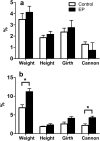Different effects of an extended photoperiod treatment on growth, gonadal function, and condition of hair coats in Thoroughbred yearlings reared under different climate conditions
- PMID: 26858576
- PMCID: PMC4739141
- DOI: 10.1294/jes.26.113
Different effects of an extended photoperiod treatment on growth, gonadal function, and condition of hair coats in Thoroughbred yearlings reared under different climate conditions
Abstract
One- to two-year-old Thoroughbred colts and fillies being reared in Miyazaki (warm climate) and Hidaka (cold climate), Japan, were administered extended photoperiod (EP) treatment between December 20 and the following April 10, and its effect on growth, endocrine changes, gonadal activation, and hair coat condition was investigated. In colts reared in Miyazaki, no effect of EP treatment was noted on the growth indices, including body weight (BW), height at withers (HW), girth, and cannon circumference (CC), whereas the BWs and CCs of fillies were significantly higher in the EP treatment group than the control. In Hidaka, the BWs and HWs of colts and HWs of fillies were significantly higher in the EP treatment group. Gonadal activation characterized by an increase in circulating hormone concentrations was earlier in the EP treatment group for fillies reared in Miyazaki [luteinizing hormone (LH), follicle-stimulating hormone (FSH), progesterone (P4), and estradiol-17β (E2)] and in colts (LH, testosterone, and E2) and fillies (LH, FSH, P4, and E2) reared in Hidaka. Regardless of sex and climate, prolactin was significantly higher in the EP treatment group, whereas insulin-like growth factor (IGF-I) was not. Initial ovulation occurred before April in more of the EP treatment group than the control regardless of the climate. Molting of the hair coat, examined in March, was advanced in the EP treatment group regardless of sex and climate. These results suggest that EP treatment may promote growth and gonadal activation in fillies reared in Miyazaki and in colts and fillies reared in Hidaka and that the effect may be mediated by prolactin.
Keywords: Thoroughbred colt and filly; climate; extended photoperiod treatment; growth; testis and ovary.
Figures










Similar articles
-
Comparison of physical body growth and metabolic and reproductive endocrine functions between north and south climates of Japan in trained Thoroughbred yearling horses.J Equine Sci. 2017;28(3):77-86. doi: 10.1294/jes.28.77. Epub 2017 Sep 20. J Equine Sci. 2017. PMID: 28955159 Free PMC article.
-
Promoting effects of an extended photoperiod treatment on the condition of hair coats and gonadal function in Thoroughbred weanlings.J Equine Sci. 2015;26(4):147-50. doi: 10.1294/jes.26.147. Epub 2016 Feb 3. J Equine Sci. 2015. PMID: 26858581 Free PMC article.
-
Comparison of growth and endocrine changes in Thoroughbred colts and fillies reared under different climate conditions.J Equine Sci. 2015;26(2):49-56. doi: 10.1294/jes.26.49. Epub 2015 Jul 2. J Equine Sci. 2015. PMID: 26170761 Free PMC article.
-
Effects of an extended photoperiod on gonadal function and condition of hair coats in Thoroughbred colts and fillies.J Equine Sci. 2015;26(2):57-66. doi: 10.1294/jes.26.57. Epub 2015 Jul 2. J Equine Sci. 2015. PMID: 26170762 Free PMC article.
-
Photo-neuroendocrine control of seasonal cycles in body weight, pelage growth and reproduction: lessons from the HPD sheep model.Comp Biochem Physiol C Pharmacol Toxicol Endocrinol. 1998 Jun;119(3):283-94. doi: 10.1016/s0742-8413(98)00017-6. Comp Biochem Physiol C Pharmacol Toxicol Endocrinol. 1998. PMID: 9827001 Review.
Cited by
-
Effects of an extended photoperiod on body composition of young Thoroughbreds in training.J Vet Med Sci. 2024 Jan 10;86(1):58-65. doi: 10.1292/jvms.23-0349. Epub 2023 Nov 16. J Vet Med Sci. 2024. PMID: 37967974 Free PMC article.
-
Comparison of physical body growth and metabolic and reproductive endocrine functions between north and south climates of Japan in trained Thoroughbred yearling horses.J Equine Sci. 2017;28(3):77-86. doi: 10.1294/jes.28.77. Epub 2017 Sep 20. J Equine Sci. 2017. PMID: 28955159 Free PMC article.
-
PATHFAST, a novel chemiluminescent enzyme immunoassay for measuring estradiol in equine whole blood and serum.J Reprod Dev. 2016 Dec 20;62(6):631-634. doi: 10.1262/jrd.2016-038. Epub 2016 Aug 20. J Reprod Dev. 2016. PMID: 27545960 Free PMC article.
-
Effects of different winter climates in Japan on body composition of young Thoroughbreds in training.J Vet Med Sci. 2022 Nov 18;84(12):1585-1594. doi: 10.1292/jvms.22-0378. Epub 2022 Oct 14. J Vet Med Sci. 2022. PMID: 36244743 Free PMC article.
-
Promoting effects of an extended photoperiod treatment on the condition of hair coats and gonadal function in Thoroughbred weanlings.J Equine Sci. 2015;26(4):147-50. doi: 10.1294/jes.26.147. Epub 2016 Feb 3. J Equine Sci. 2015. PMID: 26858581 Free PMC article.
References
-
- Arslanian S., Suprasongsin C. 1997. Testosterone treatment in adolescents with delayed puberty: changes in body composition, protein, fat, and glucose metabolism. J. Clin. Endocrinol. Metab. 82: 3213–3220. - PubMed
-
- Asai S., Ohta R., Fujikawa T., Sakai R.R., Shirota M., Ogata M., Watanabe G., Taya K. 2006. Gastric ulceration and expression of prolactin receptor in the brain in Hatano high- and low-avoidance rats. Endocrine 30: 161–166. - PubMed
-
- Bartke A. 2004. Prolactin in the male: 25 years later. J. Androl. 25: 661–666. - PubMed
-
- Bartke A., Klemcke H.G., Amador A., Van Sickle M. 1982. Photoperiod and regulation of gonadotropin receptors. Ann. N. Y. Acad. Sci. 383: 122–134. - PubMed
LinkOut - more resources
Full Text Sources
Other Literature Sources
Miscellaneous
